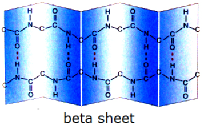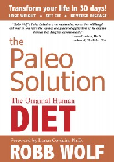Protein Structure
Proteins have a very complex structure. They are made up of chains of amino acids
in a specific sequence, which is determined by segments of the genetic code in a
cell’s DNA. The number of amino acids in the chain can vary from as little as ten
to many thousands.
Up to 20 different amino acids can be built into the protein directly from the DNA
sequence via messenger RNA. These amino acids are called the proteinogenic amino
acids.
They include the nine essential amino acids, which must be supplied in the food.
They are: histidine, isoleucine, leucine, lysine, methionine, phenylalanine, threonine,
tryptophan and valine.
The remaining 11 non-essential amino acids, which can be made in the body from other
molecules are: alanine, arginine, asparagine, aspartic acid, cysteine, glutamic acid,
glutamine, glycine, proline, serine and tyrosine.
Primary structure
The primary structure of proteins refers to the sequence of the amino acids in the
amino  acids chain or ‘polypeptide’ chain.
acids chain or ‘polypeptide’ chain.
The primary structure is held together by chemical bonds made during the synthetic
process of the protein taking place in the cells’ cytoplasma at the ribosomes, which
is  where the amino acid chain is made using the messenger RNA as a template for the
formation.
where the amino acid chain is made using the messenger RNA as a template for the
formation.
Thus the sequence of bases in messenger RNA (mRNA) - being a copy of the DNA base
sequence in the gene for the protein - is translated into the specific amino acid
sequence, which determines the special characteristics of the protein in question.
In this process transfer RNA (tRNA) is an important intermediary bringing the amino
acids in the correct position at the ribosome enabling formation of the peptide chain
(se figure).
In our body there are over 10,000 different proteins. Each protein has its own unique
number and sequence of amino acids.
Protein folding is the process by which a protein assumes its functional shape or
conformation. It is the physical process by which a polypeptide chain folds into
its characteristic and functional three-dimensional structure.
As mentioned above each protein starts as an unfolded polypeptide chain when translated
from the sequence of messenger RNA to the linear chain of amino acids.
In this chain the amino acids interact with each other to produce a well-defined
three-dimensional structure, which is the final functional form of the protein. This
form is determined by the amino acid sequence (Anfinsen's dogma).
The final three-dimensional structure of the protein is obtained through the following
additional conformations.
Secondary structure
 The secondary structure of proteins refers to regular local sub-structures, which
are formed in certain areas of the amino acid chain. There are two main types of
The secondary structure of proteins refers to regular local sub-structures, which
are formed in certain areas of the amino acid chain. There are two main types of secondary structure, the alpha helix and the beta sheet. They arise due to weak (hydrogen)
bonding between certain groups in the amino acid chain. These secondary structures
give rise to a regular geometry in certain parts of the protein molecule. Several
sequential secondary structures may form a "supersecondary unit".
secondary structure, the alpha helix and the beta sheet. They arise due to weak (hydrogen)
bonding between certain groups in the amino acid chain. These secondary structures
give rise to a regular geometry in certain parts of the protein molecule. Several
sequential secondary structures may form a "supersecondary unit".
Tertiary Structure
 The tertiary structure of proteins refers to the three-dimensional structure of the
whole single protein molecule. The alpha-helices and beta-sheets are folded into
a compact globule. The folding is driven by the non-specific hydrophobic interactions,
but the structure is stable only when the parts of a protein domain are locked into
place by specific tertiary interactions, such as salt bridges, hydrogen bonds, and
the tight packing of side chains and disulfide bonds.
The tertiary structure of proteins refers to the three-dimensional structure of the
whole single protein molecule. The alpha-helices and beta-sheets are folded into
a compact globule. The folding is driven by the non-specific hydrophobic interactions,
but the structure is stable only when the parts of a protein domain are locked into
place by specific tertiary interactions, such as salt bridges, hydrogen bonds, and
the tight packing of side chains and disulfide bonds.
Quaternary structure
 The quaternary structure of proteins is the three-dimensional structure of a multi-subunit
protein. The final 3D structure is determined by how the subunits fit together. In
this context, the quaternary structure is stabilized by the same non-covalent interactions
and disulfide bonds as the tertiary structure. Complexes of two or more polypeptides
(i.e. multiple subunits) are called multimers. Specifically it would be called a
dimer if it contains two subunits, a trimer if it contains three subunits, and a
tetramer if it contains four subunits.
The quaternary structure of proteins is the three-dimensional structure of a multi-subunit
protein. The final 3D structure is determined by how the subunits fit together. In
this context, the quaternary structure is stabilized by the same non-covalent interactions
and disulfide bonds as the tertiary structure. Complexes of two or more polypeptides
(i.e. multiple subunits) are called multimers. Specifically it would be called a
dimer if it contains two subunits, a trimer if it contains three subunits, and a
tetramer if it contains four subunits.
Proteins consist frequently of several structural subunits.
Structural domains
A structural domain is a part of the protein's overall structure that is self-stabilizing
and often folds independently of the rest of the protein chain. Many domains are
not unique to the proteins of one gene or one gene family but instead appear in a
variety of proteins. Domains often are named after their biological function in the
protein they belong to; for example, the "calcium-binding domain of calmodulin".
Because structural domains are independently stable, they can be "swapped" by genetic
engineering between different proteins.
The correct three-dimensional structure is essential to function, although some parts
of functional proteins may remain unfolded. Failure to fold into the normal structure
generally produces inactive proteins, but in some instances misfolded proteins have
a modified or toxic functionality. Several neurodegenerative and other diseases are
believed to result from the accumulation of amyloid fibrils formed by misfolded proteins.
Rererences: 1 , 2 , 3 , 4
Copyright: Know Facts - All Rights Reserved





![]() acids chain or ‘polypeptide’ chain.
acids chain or ‘polypeptide’ chain.  where the amino acid chain is made using the messenger RNA as a template for the
formation.
where the amino acid chain is made using the messenger RNA as a template for the
formation.  The secondary structure of proteins refers to regular local sub-
The secondary structure of proteins refers to regular local sub- secondary structure, the
secondary structure, the  The tertiary structure of proteins refers to the three-
The tertiary structure of proteins refers to the three- The quaternary structure of proteins is the three-
The quaternary structure of proteins is the three-